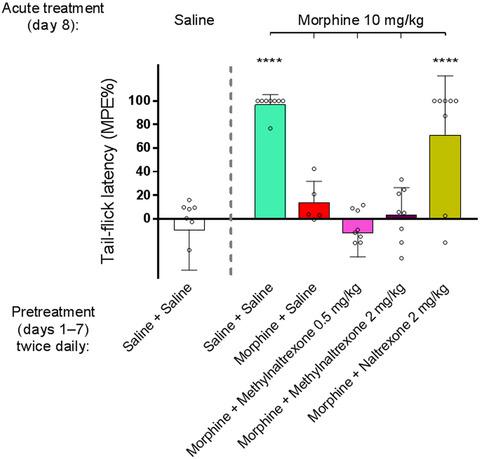当前位置:
X-MOL 学术
›
J. Neurosci. Res.
›
论文详情
Our official English website, www.x-mol.net, welcomes your
feedback! (Note: you will need to create a separate account there.)
Antagonism of peripheral opioid receptors by methylnaltrexone does not prevent morphine tolerance in rats
Journal of Neuroscience Research ( IF 2.9 ) Pub Date : 2020-05-27 , DOI: 10.1002/jnr.24638 Kim Juhani Blomqvist 1, 2 , Katarzyna Anna Dudek 1, 2 , Hanna Viisanen 1, 2 , Kert Mätlik 1, 2 , Fredrik Harry Gustav Ahlström 1, 2 , Jouko Laitila 2, 3 , Eija Anneli Kalso 1, 4 , Pekka Veli Rauhala 1, 2 , Tuomas Olavi Lilius 1, 2, 3, 5
Journal of Neuroscience Research ( IF 2.9 ) Pub Date : 2020-05-27 , DOI: 10.1002/jnr.24638 Kim Juhani Blomqvist 1, 2 , Katarzyna Anna Dudek 1, 2 , Hanna Viisanen 1, 2 , Kert Mätlik 1, 2 , Fredrik Harry Gustav Ahlström 1, 2 , Jouko Laitila 2, 3 , Eija Anneli Kalso 1, 4 , Pekka Veli Rauhala 1, 2 , Tuomas Olavi Lilius 1, 2, 3, 5
Affiliation

|
Opioids are effective analgesics in the management of severe pain. However, tolerance, leading to dose escalation and adverse effects are significant limiting factors in their use. The role of peripheral opioid receptors in analgesia has been discussed especially under inflammatory conditions. The results from pharmacological and conditional knockout studies together do not provide a clear picture of the contribution of peripheral opioid receptors on antinociceptive tolerance and this needs to be evaluated. Therefore, we studied whether the peripherally restricted opioid receptor antagonist, methylnaltrexone (MNTX), could prevent morphine tolerance without attenuating the antinociceptive effect of morphine. Male Sprague-Dawley rats were treated for 7 days with increasing subcutaneous doses of morphine (5–30 mg/kg) and were coadministered saline, MNTX (0.5 or 2 mg/kg), or naltrexone (NTX; 2 mg/kg). Nociception was assessed with tail-flick, hotplate, and von Frey tests. Morphine, MNTX, and NTX concentrations in the plasma, brain, and spinal cord were measured by liquid chromatography-tandem mass spectrometry. In acute coadministration, NTX, but not MNTX, abolished the acute antinociceptive effects of morphine in all nociceptive tests. The antinociceptive tolerance after repeated morphine administration was also prevented by NTX but not by MNTX. MNTX penetrated to the spinal cord and the brain to some extent after repeated administration. The results do not support the use of MNTX for preventing opioid tolerance and also suggest that morphine tolerance is mediated by central rather than peripheral opioid receptors in the rat.
中文翻译:

甲基纳曲酮对外周阿片受体的拮抗作用并不能阻止大鼠的吗啡耐受
阿片类药物是治疗剧烈疼痛的有效镇痛剂。然而,导致剂量增加和副作用的耐受性是其使用的重要限制因素。已经讨论了外周阿片受体在镇痛中的作用,尤其是在炎症条件下。药理学和条件性敲除研究的结果并不能清楚地说明外周阿片受体对镇痛耐受性的贡献,这需要进行评估。因此,我们研究了外周限制性阿片受体拮抗剂甲基纳曲酮 (MNTX) 是否可以在不减弱吗啡镇痛作用的情况下预防吗啡耐受。雄性 Sprague-Dawley 大鼠皮下剂量增加吗啡 (5-30 mg/kg) 治疗 7 天,同时给予生理盐水,MNTX(0.5 或 2 mg/kg)或纳曲酮(NTX;2 mg/kg)。伤害感受通过甩尾、热板和 von Frey 测试进行评估。通过液相色谱-串联质谱法测量血浆、脑和脊髓中的吗啡、MNTX 和 NTX 浓度。在急性联合给药中,NTX 而不是 MNTX,在所有伤害性测试中消除了吗啡的急性镇痛作用。NTX 也阻止了重复吗啡给药后的镇痛耐受性,但 MNTX 没有。多次给药后,MNTX在一定程度上渗透到脊髓和大脑。结果不支持使用 MNTX 预防阿片类药物耐受,并且还表明吗啡耐受性是由大鼠中枢而非外周阿片受体介导的。伤害感受通过甩尾、热板和 von Frey 测试进行评估。通过液相色谱-串联质谱法测量血浆、脑和脊髓中的吗啡、MNTX 和 NTX 浓度。在急性联合给药中,NTX 而不是 MNTX,在所有伤害性测试中消除了吗啡的急性镇痛作用。NTX 也阻止了重复吗啡给药后的镇痛耐受性,但 MNTX 没有。多次给药后,MNTX在一定程度上渗透到脊髓和大脑。结果不支持使用 MNTX 预防阿片类药物耐受,并且还表明吗啡耐受性是由大鼠中枢而非外周阿片受体介导的。伤害感受通过甩尾、热板和 von Frey 测试进行评估。通过液相色谱-串联质谱法测量血浆、脑和脊髓中的吗啡、MNTX 和 NTX 浓度。在急性联合给药中,NTX 而不是 MNTX,在所有伤害性测试中消除了吗啡的急性镇痛作用。NTX 也阻止了重复吗啡给药后的镇痛耐受性,但 MNTX 没有。多次给药后,MNTX在一定程度上渗透到脊髓和大脑。结果不支持使用 MNTX 预防阿片类药物耐受,并且还表明吗啡耐受性是由大鼠中枢而非外周阿片受体介导的。通过液相色谱-串联质谱法测量脊髓和脊髓。在急性联合给药中,NTX 而不是 MNTX,在所有伤害性测试中消除了吗啡的急性镇痛作用。NTX 也阻止了重复吗啡给药后的镇痛耐受性,但 MNTX 没有。多次给药后,MNTX在一定程度上渗透到脊髓和大脑。结果不支持使用 MNTX 预防阿片类药物耐受,并且还表明吗啡耐受性是由大鼠中枢而非外周阿片受体介导的。通过液相色谱-串联质谱法测量脊髓和脊髓。在急性联合给药中,NTX 而不是 MNTX,在所有伤害性测试中消除了吗啡的急性镇痛作用。NTX 也阻止了重复吗啡给药后的镇痛耐受性,但 MNTX 没有。多次给药后,MNTX在一定程度上渗透到脊髓和大脑。结果不支持使用 MNTX 预防阿片类药物耐受,并且还表明吗啡耐受性是由大鼠中枢而非外周阿片受体介导的。NTX 也阻止了重复吗啡给药后的镇痛耐受性,但 MNTX 没有。多次给药后,MNTX在一定程度上渗透到脊髓和大脑。结果不支持使用 MNTX 预防阿片类药物耐受,并且还表明吗啡耐受性是由大鼠中枢而非外周阿片受体介导的。NTX 也阻止了重复吗啡给药后的镇痛耐受性,但 MNTX 没有。多次给药后,MNTX在一定程度上渗透到脊髓和大脑。结果不支持使用 MNTX 预防阿片类药物耐受,并且还表明吗啡耐受性是由大鼠中枢而非外周阿片受体介导的。
更新日期:2020-05-27
中文翻译:

甲基纳曲酮对外周阿片受体的拮抗作用并不能阻止大鼠的吗啡耐受
阿片类药物是治疗剧烈疼痛的有效镇痛剂。然而,导致剂量增加和副作用的耐受性是其使用的重要限制因素。已经讨论了外周阿片受体在镇痛中的作用,尤其是在炎症条件下。药理学和条件性敲除研究的结果并不能清楚地说明外周阿片受体对镇痛耐受性的贡献,这需要进行评估。因此,我们研究了外周限制性阿片受体拮抗剂甲基纳曲酮 (MNTX) 是否可以在不减弱吗啡镇痛作用的情况下预防吗啡耐受。雄性 Sprague-Dawley 大鼠皮下剂量增加吗啡 (5-30 mg/kg) 治疗 7 天,同时给予生理盐水,MNTX(0.5 或 2 mg/kg)或纳曲酮(NTX;2 mg/kg)。伤害感受通过甩尾、热板和 von Frey 测试进行评估。通过液相色谱-串联质谱法测量血浆、脑和脊髓中的吗啡、MNTX 和 NTX 浓度。在急性联合给药中,NTX 而不是 MNTX,在所有伤害性测试中消除了吗啡的急性镇痛作用。NTX 也阻止了重复吗啡给药后的镇痛耐受性,但 MNTX 没有。多次给药后,MNTX在一定程度上渗透到脊髓和大脑。结果不支持使用 MNTX 预防阿片类药物耐受,并且还表明吗啡耐受性是由大鼠中枢而非外周阿片受体介导的。伤害感受通过甩尾、热板和 von Frey 测试进行评估。通过液相色谱-串联质谱法测量血浆、脑和脊髓中的吗啡、MNTX 和 NTX 浓度。在急性联合给药中,NTX 而不是 MNTX,在所有伤害性测试中消除了吗啡的急性镇痛作用。NTX 也阻止了重复吗啡给药后的镇痛耐受性,但 MNTX 没有。多次给药后,MNTX在一定程度上渗透到脊髓和大脑。结果不支持使用 MNTX 预防阿片类药物耐受,并且还表明吗啡耐受性是由大鼠中枢而非外周阿片受体介导的。伤害感受通过甩尾、热板和 von Frey 测试进行评估。通过液相色谱-串联质谱法测量血浆、脑和脊髓中的吗啡、MNTX 和 NTX 浓度。在急性联合给药中,NTX 而不是 MNTX,在所有伤害性测试中消除了吗啡的急性镇痛作用。NTX 也阻止了重复吗啡给药后的镇痛耐受性,但 MNTX 没有。多次给药后,MNTX在一定程度上渗透到脊髓和大脑。结果不支持使用 MNTX 预防阿片类药物耐受,并且还表明吗啡耐受性是由大鼠中枢而非外周阿片受体介导的。通过液相色谱-串联质谱法测量脊髓和脊髓。在急性联合给药中,NTX 而不是 MNTX,在所有伤害性测试中消除了吗啡的急性镇痛作用。NTX 也阻止了重复吗啡给药后的镇痛耐受性,但 MNTX 没有。多次给药后,MNTX在一定程度上渗透到脊髓和大脑。结果不支持使用 MNTX 预防阿片类药物耐受,并且还表明吗啡耐受性是由大鼠中枢而非外周阿片受体介导的。通过液相色谱-串联质谱法测量脊髓和脊髓。在急性联合给药中,NTX 而不是 MNTX,在所有伤害性测试中消除了吗啡的急性镇痛作用。NTX 也阻止了重复吗啡给药后的镇痛耐受性,但 MNTX 没有。多次给药后,MNTX在一定程度上渗透到脊髓和大脑。结果不支持使用 MNTX 预防阿片类药物耐受,并且还表明吗啡耐受性是由大鼠中枢而非外周阿片受体介导的。NTX 也阻止了重复吗啡给药后的镇痛耐受性,但 MNTX 没有。多次给药后,MNTX在一定程度上渗透到脊髓和大脑。结果不支持使用 MNTX 预防阿片类药物耐受,并且还表明吗啡耐受性是由大鼠中枢而非外周阿片受体介导的。NTX 也阻止了重复吗啡给药后的镇痛耐受性,但 MNTX 没有。多次给药后,MNTX在一定程度上渗透到脊髓和大脑。结果不支持使用 MNTX 预防阿片类药物耐受,并且还表明吗啡耐受性是由大鼠中枢而非外周阿片受体介导的。











































 京公网安备 11010802027423号
京公网安备 11010802027423号